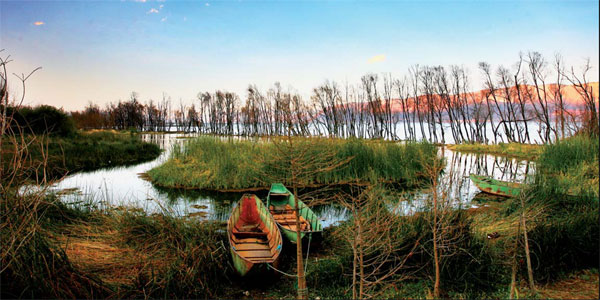Backpacker heaven
Updated: 2013-03-01 07:08
(China Daily)
|
||||||||
|
Erhai, one of China's largest highland lakes, is an enchanting place for tourists who love a tranquil environment and photography. Provided to China Daily |
Dali's mixture of culture, climate, nature and cuisine has made it a big attraction
Dali's interesting ethnic culture, enticing food, ancient architecture - including a city wall and moat - and sub-tropical climate have placed it firmly at the top of many travelers destinations in China and earned it the moniker "backpacker heaven".
The Bai ethnic group has lived in the Dali area for thousands of years and still accounts for 65 percent of the population. Their culture, which includes a multitude of celebrations - among them the Butterfly Festival and the March Street Festival in spring - is a huge draw for tourists.
In northwest Yunnan province, 300 kilometers from the region's capital, Kunming, Dali sits between Cangshan Mountain to the west and Erhai Lake to the east. Both of these natural spots are popular trips for visitors from China and abroad to Dali.
Here are some of the main attractions.
1. Cangshan Mountain

Its 19 peaks rise 3,500 meters above sea level, creating an undulating landscape dotted with rocks and springs and in parts shrouded in cloud. Snow on the mountaintops remains unmelted year-round and sparkles in the sun.
The mountain is a national park and home to some of the rarest camellia flowers in China. Flower and bird enthusiasts should stay at least one night at a mountain guesthouse to enjoy the natural beauty and serenity of the mountain, the equal of which is hard to find in China.
The main path on Cangshan Mountain is called the Cloud Traveler's Path, which crosses 18 streams and winds its way through dense forest.
As altitude changes along the path, so too do the clouds, at times becoming as thin as silk and at others as thick as jade. It you come across a cloud that resembles a fairy holding a jade belt it is supposedly a sign of good health, according to Bai legend.
When it is shrouded in cloud, a walk on the mountain can be a surreal experience, while on a clear day it offers spectacular views of the entire Dali valley.
2. Three Pagodas
Located at the foot of Cangshan Mountain and facing Erhai Lake, Three Pagodas is one of the best-preserved Buddhist structures in China.
The central structure, Qianxun Pagoda, is one of the tallest remaining pagodas of the Tang Dynasty (AD 618-907) at 69.13 meters. To its north and south stand two smaller pagodas. Along with Zhaozhou Bridge in Hebei province and Big Wild Goose Pagoda in Xian, Shaanxi province, Three Pagodas is considered one of the architectural wonders of the Tang Dynasty.
Its complex structure and beauty reflect the Buddhism that once swept the entire region.
Congshen Temple, which is behind Three Pagodas, was recently rebuilt. It contains sculptures of Buddha made from wood, silver, gold and crystal.
Those energetic enough to climb to the top of the main pagoda are rewarded with a panoramic view of Dali and Erhai Lake.
Following the pagodas, a visit to the nearby Marble Market, which is lined with souvenir shops, many selling Dali's unique marble carvings, makes an interesting diversion.
3. Erhai Lake
One of China's largest highland lakes, Erhai Lake means "ear-shaped sea" in Chinese. The lake, which is next to Cangshan Mountain, covers an area of 250 square kilometers and is shaped in a crescent curling around Dali. It was a natural protection for the town in more dangerous times.
On a sunny day shreds of sunlight streak down upon this watery armor, dispersing on its surface to create a shimmering pool of color that contrasts with the glistening pinnacles of Cangshan Mountain. This is commonly referred to as "Silver Cangshan and Jade Erhai".
Ferries and paddle boats wait to take travelers around the lake, where they can watch trained cormorants working with fishermen to bring in their daily catch.
There are also a number of islands and temples around the lake that are worth visiting, including Golden Shuttle Island and Guanyin Temple.
4. Local Food
Dali is known for its Bai ethnic dishes. Stewed carp casserole is a local delicacy, normally served as a main course with 28 different ingredients and numerous seasonings.
Steamed chicken is cooked in a pot and the circulating vapor inside makes the chicken taste more tender than typically boiled or stewed chicken, especially when traditional Chinese herbs are added.
Dairy Fan is a popular snack made of milk and yogurt, shaped like a fan, which is served at stalls dotted throughout Dali.
Another favorite local snack is Ba Ba, a tiny baked pancake with onions and diced ham.
China Daily
(China Daily 03/01/2013 page22)

 Li Na on Time cover, makes influential 100 list
Li Na on Time cover, makes influential 100 list
 FBI releases photos of 2 Boston bombings suspects
FBI releases photos of 2 Boston bombings suspects
 World's wackiest hairstyles
World's wackiest hairstyles
 Sandstorms strike Northwest China
Sandstorms strike Northwest China
 Never-seen photos of Madonna on display
Never-seen photos of Madonna on display
 H7N9 outbreak linked to waterfowl migration
H7N9 outbreak linked to waterfowl migration
 Dozens feared dead in Texas plant blast
Dozens feared dead in Texas plant blast
 Venezuelan court rules out manual votes counting
Venezuelan court rules out manual votes counting
Most Viewed
Editor's Picks

|

|

|

|

|

|
Today's Top News
Boston bombing suspect reported cornered on boat
7.0-magnitude quake hits Sichuan
Cross-talk artist helps to spread the word
'Green' awareness levels drop in Beijing
Palace Museum spruces up
First couple on Time's list of most influential
H7N9 flu transmission studied
Trading channels 'need to broaden'
US Weekly

|

|








